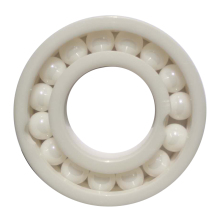Factory direct stainless steel bolt plastic bearing Xingruida rolling bearing customized
The extrusion system consists of screw, barrel, hopper, head and die. The plastic is plasticized into a uniform melt through the extrusion system, and under the pressure established in this process, it is continuously extruded by the screw.
Screw: is the most important part of the extruder, which is directly related to the application scope and productivity of the extruder. It is made of high-strength and corrosion-resistant alloy steel.
(2) barrel: it is a metal cylinder, which is generally made of alloy steel or composite steel pipe lined with alloy steel with high heat resistance, high compressive strength, strong wear resistance and corrosion resistance. The barrel and screw cooperate to crush, soften, melt, plasticize, exhaust and compact the plastics, and continuously and evenly transport the rubber to the molding system. The length of the plastic cylinder and the diameter of the plastic cylinder should be fully heated to 15-30 times.
Plastic extruder (15 sheets)
(3) hopper: a cut-off device is installed at the bottom of the hopper to adjust and cut off the material flow, and a sight hole and calibration metering device are installed at the side of the hopper.
(4) head and die: the head is composed of alloy steel inner sleeve and carbon steel outer sleeve. The head is equipped with a forming die. The function of the head is to transform the plastic melt in rotary motion into parallel linear motion, evenly and smoothly lead it into the die sleeve, and give the plastic with the necessary forming pressure. The plastic is plasticized and compacted in the barrel, and flows into the forming die of the head through the neck of the head along a certain flow channel through the porous filter plate. The core and sleeve of the die are properly matched to form an annular gap with decreasing cross section, so that the plastic melt forms a continuous and dense tubular coating around the core. In order to ensure that the plastic flow channel in the die is reasonable and eliminate the dead angle of accumulated plastic, a shunt sleeve is often installed. In order to eliminate the pressure fluctuation during plastic extrusion, a pressure equalizing ring is also set. The die head is also equipped with a device for die correction and adjustment, which is convenient for adjusting and correcting the concentricity of the die core and the die sleeve.
According to the angle between the material flow direction of the head and the center line of the screw, the head of the extruder is divided into oblique head (angle 120o) and right angle head. The shell of the machine head is fixed on the machine body with bolts. The mould in the machine head has a mould core seat, which is fixed on the wire inlet port of the machine head with nuts. A mould core is installed in the front of the mould core seat, and there are holes in the center of the mould core and the mould core seat, which are used to pass through the core wire. A grading ring is installed in the front of the machine head to balance the pressure. The extrusion forming part is composed of a mould sleeve seat and a mould sleeve, and the position of the mould sleeve can be passed by bolts Support to adjust, so as to adjust the relative position of the die sleeve to the die core, so as to adjust the uniformity of the extrusion layer thickness. The outside of the die head is equipped with a heating device and a temperature measuring device.
drive system
The function of the transmission system is to drive the screw and supply the torque and speed needed by the screw in the extrusion process. It is usually composed of motor, reducer and bearing.
 Audited supplier
Audited supplier1、 Several important geometric parameters of screw: 1. Screw diameter (d) A. It is related to the required injection volume: injection volume = 1 / 4 * π * D2 * s (injection stroke) * 0.85; B. generally speaking, screw diameter D is inversely proportional to the maximum injection pressure and directly proportional to the plasticizing ability. 2. Conveying section a is responsible for conveying, pushing and preheating plastics, which should be preheated to the melting point; B. crystalline plastics should be long (such as POM and PA), followed by amorphous materials (such as PS, PU and ABS), with the shortest thermal sensitivity (such as PVC). 3. Compression section a is responsible for the mixing, compression and pressurized exhaust of plastics, through which almost all the raw materials have been melted, but not necessarily mixed evenly; B. in this area, the plastic gradually melts, and the screw groove volume must be reduced accordingly to correspond to the decrease of plastic geometric volume, otherwise, the material pressure is not solid, the heat transfer is slow, and the exhaust is poor; C. generally, it accounts for more than 25% of the screw working length, However, the compression section of nylon (crystalline material) screw accounts for about 15% of the screw working length, plastic screw with high viscosity, fire resistance, low conductivity and high additives accounts for 40% - 50% of the screw working length, and PVC screw accounts for 100% of the screw working length, so as to avoid intense shear heat. 4. Metering section a, generally 20-25% of the screw working length, to ensure that all plastic melting and temperature uniformity, mixing uniformity; B, metering section long, mixing effect is good, too long is easy to make the melt stay too long and produce thermal decomposition, too short is easy to make the temperature uneven; C, PVC and other heat sensitive plastic materials should not stay too long, to avoid thermal decomposition, can use a shorter metering section or not metering section . 5. A. the deeper the depth of the feeding screw groove, the larger the conveying capacity, but the screw strength should be considered. The shallower the depth of the metering screw groove, the higher the plasticizing heat and mixing performance index. However, if the depth of the metering screw groove is too shallow, the shear heat and self generated heat will increase, and the temperature rise will be too high, which will cause discoloration or scorch of the plastic, especially not conducive to the thermosensitive plastic The depth of screw groove = Kd = (0.03-0.07) * D. if D increases, K will be selected as a small value. 2、 The main factors affecting the plasticizing quality are: length diameter ratio, compression ratio, back pressure, screw speed, barrel heating temperature, etc. 1. Length diameter ratio: the ratio of effective working length and diameter of screw.
"Jingheng machinery" screw source manufacturers focus on high precision screw
Advertising professional engaged in screw, barrel and accessories design, research and development, production, technical services. Can carry on the field survey and design for the customer. View details >
a. If the ratio of length to diameter is large, the feed is easy to be uniform; B. for plastics with better thermal stability, a longer screw can be used to improve the mixing performance without scorching; for plastics with poor thermal stability, a shorter screw or screw end without thread can be used. Considering the characteristics of plastics, the general flow length ratio is as follows: thermosetting is 14-16, heat sensitivity of rigid PVC, high viscosity Pu is 17-18, general plastics is 18-22, high temperature stability plastics such as PC, POM is 22-24. 2. Compression ratio: the ratio of the depth of the last screw groove in the feeding section to the depth of the first screw groove in the metering section. a. Considering the compressibility, filling degree, reflux and other effects of the material, the product should be dense, heat transfer and exhaust; B. appropriate compression ratio can increase the density of the plastic, make the combination between molecules more closely, help to reduce the absorption of air, The higher the compression ratio is, the higher the temperature rise in the plasticizing process of the plastic in the pipe will be, the better the mixing uniformity of the plastic in the plasticizing process will be, and the relative discharge quantity will be greatly reduced; D. high compression ratio is suitable for non fusible plastics, especially for low melting Low compression ratio is suitable for fusible plastics, especially for high melting viscosity and heat sensitive plastics. 3. Back pressure A. increasing the back pressure can increase the work done by the screw on the molten resin, eliminate the unmelted plastic particles, and increase the density and uniformity of raw materials in the tube; B. back pressure is used to increase the barrel temperature, and the effect is most significant; C. too large back pressure is easy to decompose the plastic with high heat sensitivity, and salivation may occur on the plastic with low viscosity There may be bubbles in the finished product. 4. Screw speed a, screw rotation speed directly affect the plastic shear in the spiral groove; B, small screw groove shallow, absorb heat quickly, enough to promote the plastic softening in the compression period, the friction heat between screw and barrel wall is low, suitable for high-speed rotation, increase the plasticization energy; C, large screw is not suitable for rapid rotation, so as to avoid uneven plasticization and excessive friction heat; d. For plastics with high heat sensitivity, if the screw speed is too high, the plastics will be easy to decompose; e. generally, the screw of various sizes has a certain speed range, generally 100-150rpm; if the screw speed is too low, the plastics cannot be melted; if the screw speed is too high, the plastics will be scorched. 5. Electric heating temperature setting A. make the cold and hard plastic remaining in the barrel and screw melt to facilitate screw rotation and provide part of the heat required for plastic melting; B. set 5-10 ℃ lower than the melt temperature (part of which is provided by friction heat energy); C. adjust the nozzle temperature to control problems such as salivation, condensate (plug) and wire drawing; D. general temperature of crystalline plastic Control.
 Audited supplier
Audited supplier
Factory direct sales zirconia ceramic bearings 6202CE XINGRUIDA rolling bearing suppliers

Zirconia ceramic bearing 6200CE high temperature bearing xingruida bearing supplier

Ceramic bearing ceramic structural parts Xingruida bearing supplier

Zirconia full ball ceramic bearing 6205CEF Xingruida corrosion resistant bearing supplier

Factory direct supply deep groove ball bearing 6205-2RS Xingruida rolling bearing custom

Thrust ball plastic bearing 51206 pom Xingruida flat plastic bearing supplier

Manufacturer direct-selling Hybrid Ball Ceramic bearing 6203CE XINGRUIDA bearing supplier

Factory direct export spherical ceramic bearing with seat Xingruida Zirconia ceramic bearing suppliers

Angular contact ball bearing zirconia ceramic bearing 7205CE XINGRUIDA bearing machine tool ceramic bearing factory








